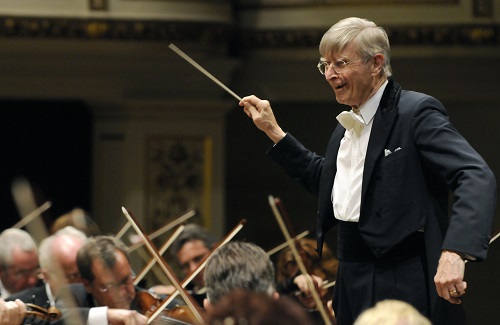 United States Beethoven, Mendelssohn: Cleveland Orchestra / Herbert Blomstedt (conductor), Severance Hall, Cleveland, Ohio, 21.2.2019. (MSJ)
United States Beethoven, Mendelssohn: Cleveland Orchestra / Herbert Blomstedt (conductor), Severance Hall, Cleveland, Ohio, 21.2.2019. (MSJ)

Beethoven – Symphony No.6 in F major, Op.68 (‘Pastoral’)
Mendelssohn – Symphony No.3 in A minor, Op.56 (‘Scottish’)
I have heard many readings of Beethoven’s Sixth that demonstrate how familiarity can unfold on pleasant but uneventful autopilot. But Herbert Blomstedt and the Cleveland Orchestra proved that it is possible to conform to tradition while remaining fresh and alive, as if the ink were still wet on the page.
Conducting with the score on his stand, unopened, and without a baton, Blomstedt’s gestures were minimal but shrewdly chosen. At age 91, he knows what is necessary and jettisons any kind of grandstanding. After an initial invigorating tempo, he let the strings guide themselves, only shaping a few turns of phrase, turning his attention to the grace notes in the woodwinds to make sure that they were snapped with a lithe rhythm. In just a few seconds, it was a masterclass on how to communicate intentions without wasting musicians’ time, and the orchestra clearly loved it, giving the conductor their finest response and concentration.
The second movement ‘scene by the brook’ burbled and flowed, unlike so many soporific outings. In addition to the flowing tempo, the effect was achieved by a flexible transition from section to section. Compared to how this orchestra plays the same piece under music director Franz Welser-Möst, this was less rigid, a bit slower, and with a noticeably warmer orchestral tone. Yet because of Blomstedt’s wisdom and experience, the movement seemed to go by quicker. The birdsong solos at the end were delivered with a sense of wonder by Joshua Smith (flute), Frank Rosenwein (oboe), and Afendi Yusuf (clarinet).
The dancing peasants of the scherzo were mellow at first, but kicked up their heels for the contrasting trio, and Blomstedt ensured that balances allowed the winds’ countermelodies to be heard. The abrupt arrival of the calm before the storm brought the kind of chill that can only come from reaching beyond the written page to get at the essence of the music. Blomstedt’s storm was neither rigidly classical nor particularly violent but felt like a human perception of a storm. And he entered the finale’s song of thanksgiving with straightforward simplicity.
For Mendelssohn’s Scottish Symphony, Blomstedt’s direction was more complex, as this more troubled work requires. It can be easy to forget — thanks to the haphazard order in which Mendelssohn’s symphonies were published (and revised) — that the Third is essentially the crown of the composer’s work as a symphonist. In Blomstedt’s hands, it felt like the masterpiece it is.
Eric Sellen’s program notes dwelt rather a lot on the independence of Mendelssohn’s craft from its Scottish inspiration. Though the work quotes no folk melodies from the country, the gloom and half-light of the composer’s inverted chords and prevailing minor keys seem to take more than just incidental inspiration from the Scottish climate. With such potentially tricky textures, a skilled hand is needed — exactly what Blomstedt brought.
Blomstedt has been pondering the work since he recorded it with the San Francisco Symphony in 1991. He now goes a little beyond the written score to give the large first movement shape. He started the introduction at a faster tempo than is traditional, and not encouraging clotting in those richly saturated middle voices in the strings and woodwinds. He then started the main body of the movement slightly slower than normal, so that each triplet of the 6/8 metre matched the pulse of each beat of the 3/4 introduction. Mendelssohn’s printed score doesn’t demand this, but upon repetition of the main theme, Blomstedt’s plan became clear. Having linked the introduction to the main theme by pulse, he pushed forward slightly for the repetition of the theme with fuller scoring and growing dynamics, leading to the faster tempo marked in the score, for the vigorous bridge into the lonely second theme. This tiered effect effectively clarified the structure, controlling its ebb and flow.
With a lively clarinet solo, Yusuf led off the colorful scherzo, infectiously contrasting with the dark opening movement. Blomstedt kept his speeds moderate, leaving a little room for flexibility, but the slow movement was more urgent than usual. The finale was appropriately warlike, though just before the coda, the lamenting wind solos achieved chilling stillness. If that coda seemed surprisingly bold as soon as it started, a quick glance at the score proves that, here, Blomstedt was doing exactly what was written: without transition, it starts its proud song forte, and only gets bolder from there to the end.
Since his regular Cleveland appearances began in 2006, Blomstedt has become a beloved visitor, and the ovations recognized his sagacity.
Mark Sebastian Jordan
